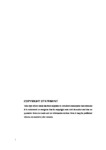Testing Market Efficiency of MENA Equity Returns
| dc.contributor.supervisor | Nawaz, Tasawar | |
| dc.contributor.author | Shehata, Mohamed Samy Saadeldeen Ahmed | |
| dc.contributor.other | Plymouth Business School | en_US |
| dc.date.accessioned | 2022-10-25T14:30:09Z | |
| dc.date.issued | 2022 | |
| dc.identifier | 10564335 | en_US |
| dc.identifier.uri | http://hdl.handle.net/10026.1/19754 | |
| dc.description.abstract |
This study focuses on the MENA region, which comprises Bahrain, Egypt, Israel, Jordon, Kuwait, Oman, Qatar, Saudi Arabia, United Arab Emirates, Lebanon, Tunisia, and Morocco. Although the MENA countries have overseen many reforms throughout the years after forming financial markets, the efficacies of these markets remain uncertain. To address this lacuna in the literature, this study explores the market efficiencies of the MENA financial markets by comparing and contrasting the impact of reforms on market efficiencies, studying the most effective macroeconomic variables and the impact of economic policy uncertainty, and transparency on stock returns. The study also investigates how Stock Market Efficiency responds asymmetrically to different macroeconomic policies, transparency, and economic policy uncertainty. The study measures the efficiency of stock exchanges in 14 countries in the MENA region through momentum, short-term reversal, delay, autocorrelation and variance ratio tests following Griffin et al. (2010) and Jegadeesh (1990). Using data from the MENA region, the study analyses the effect of macroeconomic variables (MEV), the economic policy uncertainty and transparency variables on stock returns in the MENA countries. The SVAR model is employed to capture the interrelations and the dependencies of MEV on stock returns. Variance decomposition and impulse response function techniques are developed to analyse the reaction and percentage contribution of the dynamic system in response to shocks. Bai-Perron (1975) is employed to control the multiple break months in market efficiency variable. Results show that there is an impact of macroeconomic variables on Stock Market Efficiency before and after the breakpoint. Results show that the stock return responds differently to the MEV shocks depending on the economic conditions. The study uses a nonlinear autoregressive distributed lag (NARDL) framework to examine the asymmetric long and short run relation between the momentum investing strategy shock that supervises the efficiency of the stock market and macroeconomic variables (fiscal and monetary policies). These results suggest that investors should adjust their investment strategies to the changes in the instruments of fiscal and monetary policies and consider the asymmetry when forecasting and managing the negative effects of unexpected events. | en_US |
| dc.language.iso | en | |
| dc.publisher | University of Plymouth | |
| dc.subject | Stock Market Efficiency | en_US |
| dc.subject | Macroeconomic Variables | |
| dc.subject.classification | PhD | en_US |
| dc.title | Testing Market Efficiency of MENA Equity Returns | en_US |
| dc.type | Thesis | |
| plymouth.version | publishable | en_US |
| dc.identifier.doi | http://dx.doi.org/10.24382/915 | |
| dc.identifier.doi | http://dx.doi.org/10.24382/915 | |
| dc.rights.embargodate | 2023-10-25T14:30:09Z | |
| dc.rights.embargoperiod | 12 months | en_US |
| dc.type.qualification | Doctorate | en_US |
| rioxxterms.version | NA | |
| plymouth.orcid.id | 0000-0002-5615-7643 | en_US |
Files in this item
This item appears in the following Collection(s)
-
01 Research Theses Main Collection
Research Theses Main


